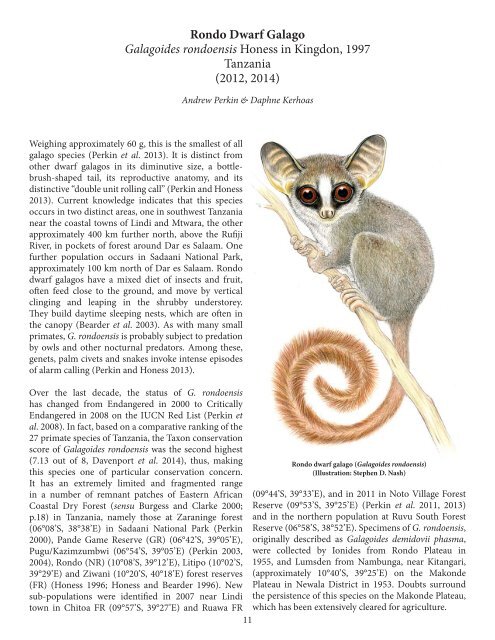Primates in Peril
f12q6x
f12q6x
Create successful ePaper yourself
Turn your PDF publications into a flip-book with our unique Google optimized e-Paper software.
Rondo Dwarf Galago<br />
Galagoides rondoensis Honess <strong>in</strong> K<strong>in</strong>gdon, 1997<br />
Tanzania<br />
(2012, 2014)<br />
Andrew Perk<strong>in</strong> & Daphne Kerhoas<br />
Weigh<strong>in</strong>g approximately 60 g, this is the smallest of all<br />
galago species (Perk<strong>in</strong> et al. 2013). It is dist<strong>in</strong>ct from<br />
other dwarf galagos <strong>in</strong> its dim<strong>in</strong>utive size, a bottlebrush-shaped<br />
tail, its reproductive anatomy, and its<br />
dist<strong>in</strong>ctive “double unit roll<strong>in</strong>g call” (Perk<strong>in</strong> and Honess<br />
2013). Current knowledge <strong>in</strong>dicates that this species<br />
occurs <strong>in</strong> two dist<strong>in</strong>ct areas, one <strong>in</strong> southwest Tanzania<br />
near the coastal towns of L<strong>in</strong>di and Mtwara, the other<br />
approximately 400 km further north, above the Rufiji<br />
River, <strong>in</strong> pockets of forest around Dar es Salaam. One<br />
further population occurs <strong>in</strong> Sadaani National Park,<br />
approximately 100 km north of Dar es Salaam. Rondo<br />
dwarf galagos have a mixed diet of <strong>in</strong>sects and fruit,<br />
often feed close to the ground, and move by vertical<br />
cl<strong>in</strong>g<strong>in</strong>g and leap<strong>in</strong>g <strong>in</strong> the shrubby understorey.<br />
They build daytime sleep<strong>in</strong>g nests, which are often <strong>in</strong><br />
the canopy (Bearder et al. 2003). As with many small<br />
primates, G. rondoensis is probably subject to predation<br />
by owls and other nocturnal predators. Among these,<br />
genets, palm civets and snakes <strong>in</strong>voke <strong>in</strong>tense episodes<br />
of alarm call<strong>in</strong>g (Perk<strong>in</strong> and Honess 2013).<br />
Over the last decade, the status of G. rondoensis<br />
has changed from Endangered <strong>in</strong> 2000 to Critically<br />
Endangered <strong>in</strong> 2008 on the IUCN Red List (Perk<strong>in</strong> et<br />
al. 2008). In fact, based on a comparative rank<strong>in</strong>g of the<br />
27 primate species of Tanzania, the Taxon conservation<br />
score of Galagoides rondoensis was the second highest<br />
(7.13 out of 8, Davenport et al. 2014), thus, mak<strong>in</strong>g<br />
Rondo dwarf galago (Galagoides rondoensis)<br />
this species one of particular conservation concern.<br />
(Illustration: Stephen D. Nash)<br />
It has an extremely limited and fragmented range<br />
<strong>in</strong> a number of remnant patches of Eastern African (09°44’S, 39°33’E), and <strong>in</strong> 2011 <strong>in</strong> Noto Village Forest<br />
Coastal Dry Forest (sensu Burgess and Clarke 2000; Reserve (09°53’S, 39°25’E) (Perk<strong>in</strong> et al. 2011, 2013)<br />
p.18) <strong>in</strong> Tanzania, namely those at Zaran<strong>in</strong>ge forest and <strong>in</strong> the northern population at Ruvu South Forest<br />
(06°08’S, 38°38’E) <strong>in</strong> Sadaani National Park (Perk<strong>in</strong> Reserve (06°58’S, 38°52’E). Specimens of G. rondoensis,<br />
2000), Pande Game Reserve (GR) (06°42’S, 39°05’E), orig<strong>in</strong>ally described as Galagoides demidovii phasma,<br />
Pugu/Kazimzumbwi (06°54’S, 39°05’E) (Perk<strong>in</strong> 2003, were collected by Ionides from Rondo Plateau <strong>in</strong><br />
2004), Rondo (NR) (10°08’S, 39°12’E), Litipo (10°02’S, 1955, and Lumsden from Nambunga, near Kitangari,<br />
39°29’E) and Ziwani (10°20’S, 40°18’E) forest reserves (approximately 10°40’S, 39°25’E) on the Makonde<br />
(FR) (Honess 1996; Honess and Bearder 1996). New Plateau <strong>in</strong> Newala District <strong>in</strong> 1953. Doubts surround<br />
sub-populations were identified <strong>in</strong> 2007 near L<strong>in</strong>di the persistence of this species on the Makonde Plateau,<br />
town <strong>in</strong> Chitoa FR (09°57’S, 39°27’E) and Ruawa FR which has been extensively cleared for agriculture.<br />
11


